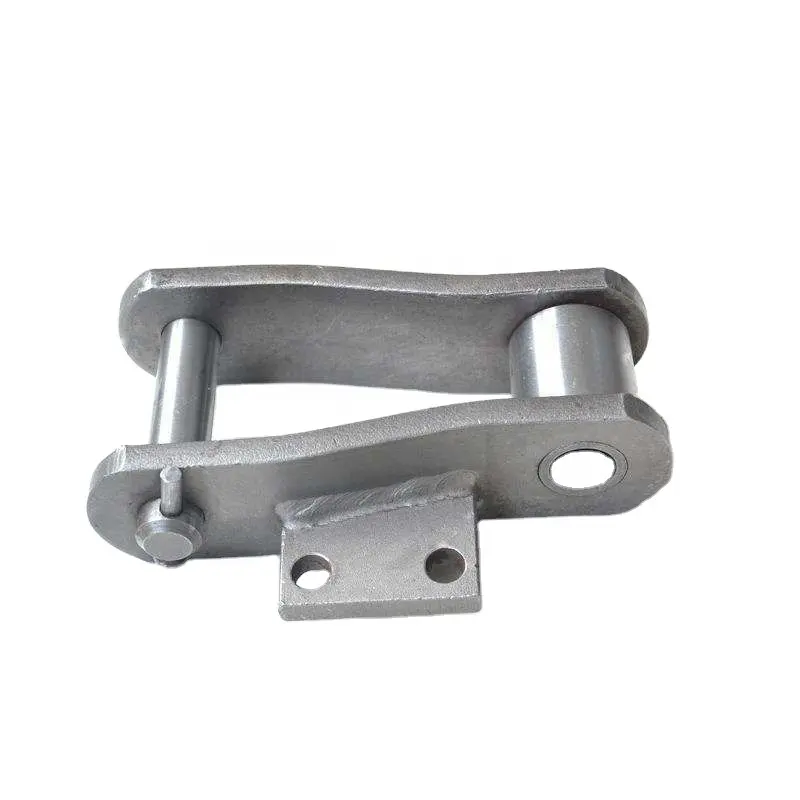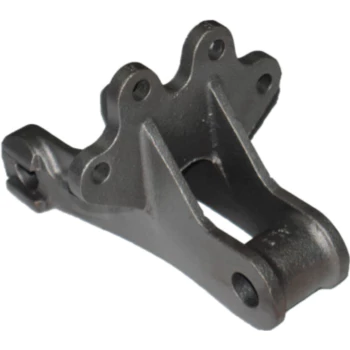Product Description
Description
General Products Application /Service Area:
Metal parts for vehicle, agriculture machine, construction machine, transportation equipment, Valve and Pump system. E.g. Engine bracket, truck chassis bracket, gear box , gear housing , gear cover, shaft, spline shaft , pulley, flange, connection pipe, pipe, hydraulic valve, valve housing ,Fitting , flange, wheel, flywheel, oil pump housing, starter housing, coolant pump housing, transmission shaft , transmission gear, sprocket, chains etc.
scraper conveyor chain
The scraper conveyor chain can be used to transport bulk materials in horizontal, inclined and vertical directions. It is often used for the transportation of raw grain, semi-finished products and finished products in grain and oil, feed processing plants. The scraper conveyor chain is suitable for the transportation of oil in the production process of grease processing plants. Transportation of raw grain from grain warehouse.
It has the advantages of simple structure, good sealing, simple feeding and unloading device, multi-point feeding and unloading, flexible layout, and the ability to complete material transportation in multiple directions at the same time. The scraper conveyor chain of ZheJiang CHINAMFG Chain Factory adopts medium carbon quenched and tempered steel and cold heading die steel. The steel is moderately priced and easy to process. After proper heat treatment, a certain degree of toughness, plasticity and wear resistance can be obtained. Normalizing can promote the spheroidization of the structure and is suitable for surface hardening treatments such as high-frequency quenching and flame quenching. Application: After quenching and tempering, it can be used to manufacture medium load and medium speed work. The working principle of the scraper conveyor is to use the open chute as a bearing part for coal, gangue or materials, and fix the scraper on the chain (to form a scraper chain) as a traction member. When the driving part of the machine head starts, the sprocket on the driving head shaft rotates, so that the scraper chain circulates and moves the animal material along the chute until it reaches the machine head to unload. The scraper chain bypasses the sprocket and runs in a stepless closed loop to complete the transportation of materials. Other scraper conveyor chain uses and maintenance precautions have to be communicated with the supplier. The above information is for reference only.
China chain manufacturer iron chain hardened steel chain scraper conveyor
Product Description
|
Customized Service Chain Conveyor Belt Stainless Steel |
|||||||||||||||||||||
|
Production Process |
Forging, press, plus machining ,heat treatment , assembly |
||||||||||||||||||||
|
Blanks Tolerance: |
FAQ: 1. Are you a manufacturer or a trading company?
.shipping-cost-tm .tm-status-off{background: none;padding:0;color: #1470cc}
Can pintle chains be used in forestry and timber processing equipment?Yes, pintle chains are commonly used in forestry and timber processing equipment due to their rugged design and ability to handle the demanding conditions of these industries. Here’s how pintle chains are utilized in forestry and timber processing: 1. Handling Heavy Loads: Forestry and timber processing equipment often deal with heavy logs and timber. Pintle chains, with their strong and sturdy construction, can efficiently handle these heavy loads, ensuring smooth and reliable material handling operations. 2. Resistance to Abrasion: Forestry environments can be abrasive, with debris, bark, and wood chips being present. Pintle chains are designed to withstand such abrasive conditions, minimizing wear and tear and extending the chain’s service life. 3. Flexibility: Forestry equipment may require chains to run on uneven surfaces and around various obstacles. Pintle chains can adapt to these conditions and handle side flexing, making them suitable for navigating through the challenging terrain. 4. Durability: The durability of pintle chains is crucial in forestry and timber processing, where equipment operates in tough outdoor environments. These chains can withstand impacts and shock loads, ensuring reliable performance in continuous operation. 5. Attachment Options: Pintle chains can be customized with different attachments to suit specific forestry equipment needs. Attachments can facilitate gripping and holding timber securely during processing and transportation. 6. Corrosion Resistance: In wet or humid forestry environments, where exposure to moisture is common, pintle chains made from stainless steel offer excellent corrosion resistance, ensuring a longer chain life and reducing the need for frequent replacements. 7. Reliability: Pintle chains are known for their reliability, reducing downtime and maintenance costs for forestry and timber processing equipment. Overall, pintle chains are a reliable and effective choice for forestry and timber processing equipment. Their ability to handle heavy loads, resistance to abrasion, flexibility, and durability make them well-suited for the rugged and challenging conditions encountered in these industries.
How do pintle chains perform in dusty or dirty environments?Pintle chains are well-suited for use in dusty or dirty environments due to their robust design and construction. They can perform effectively in such conditions, provided that proper maintenance and precautions are taken. Here are some key points about how pintle chains handle dusty or dirty environments:
By following proper maintenance practices and using the appropriate chain material, pintle chains can reliably perform in dusty or dirty environments. However, it is essential to regularly inspect the chain’s condition and take corrective actions to prevent premature wear and maintain smooth operation.
How does a pintle chain differ from other types of conveyor chains?A pintle chain differs from other types of conveyor chains in its unique design and specific use cases. Here’s a more detailed explanation of the differences between pintle chains and other conveyor chains:
On the other hand, standard roller chains have evenly spaced pins and are commonly used in less demanding applications where precision and speed are not critical. They are suitable for conveying lighter loads and are commonly found in industries like automotive, packaging, and general manufacturing. In summary, the key differences between pintle chains and other conveyor chains lie in their design, use of sprockets, specific applications, conveyor configurations, attachment options, and construction materials. Pintle chains are preferred for heavy-duty applications requiring positive drive, whereas standard roller chains are suitable for lighter-duty applications with less stringent requirements.
| ||||||||||||||||||||









